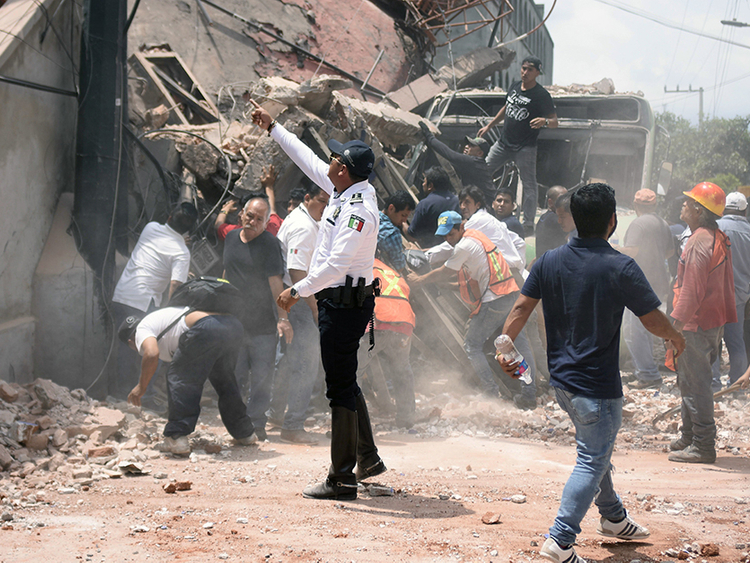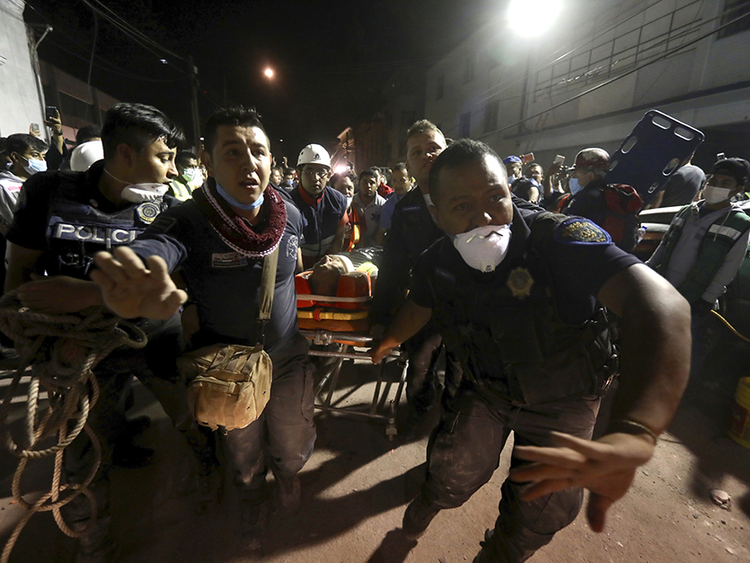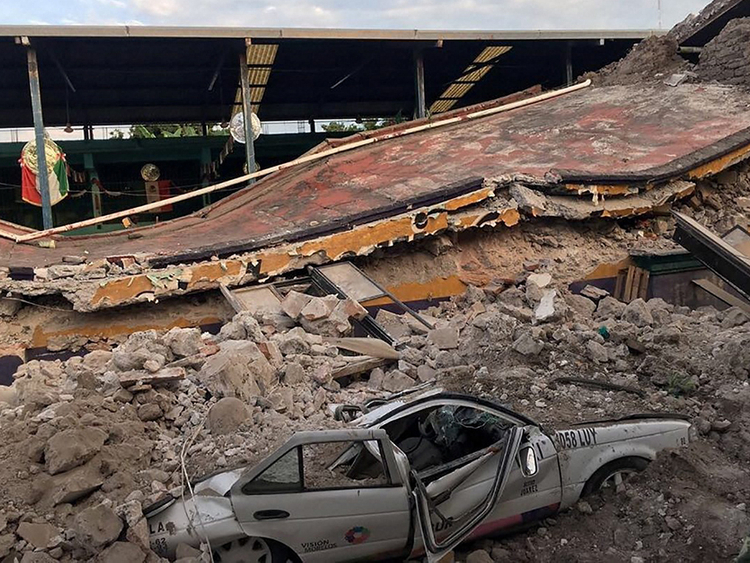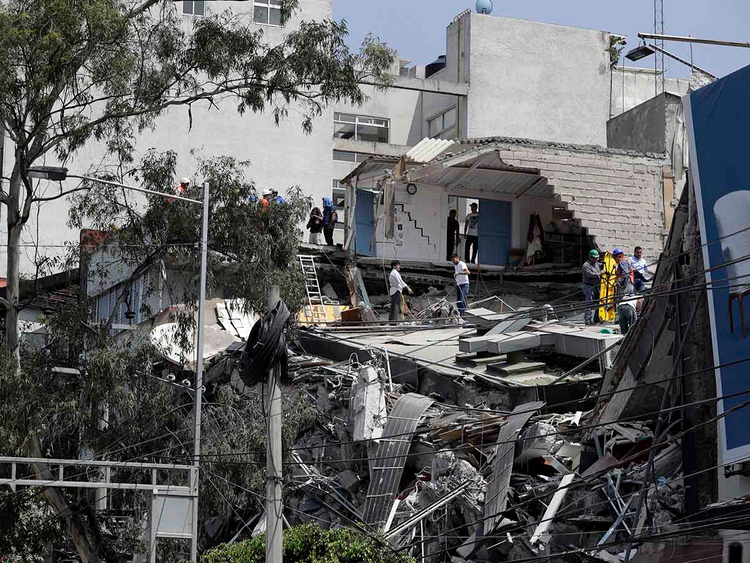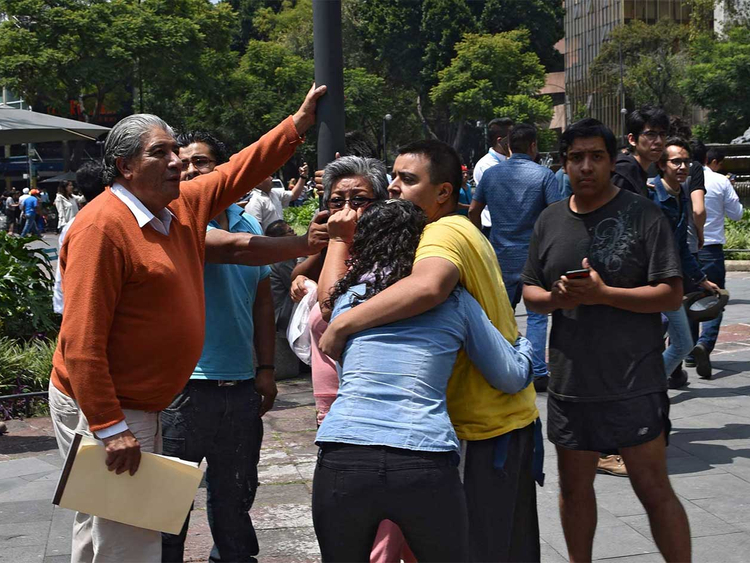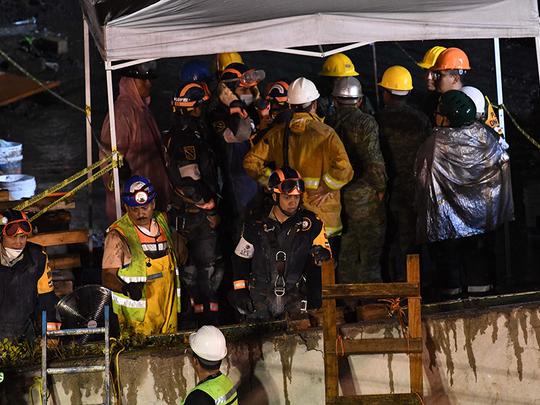
Climbing onto a pile of rubble that used to be a building may not seem the most obvious thing to do for someone who has just survived an earthquake.
But that is how thousands of Mexicans have reacted to the deadly 7.1-magnitude quake that rocked the country Tuesday, killing more than 200 people.
Businessmen in ties, students in jeans, doctors in scrubs and other ordinary people from all walks of life have joined professional rescue teams in rushing onto and into the mangled remains of homes, schools and offices in Mexico City, desperately trying to reach survivors before it's too late.
The outpouring of sympathy has been overwhelming - too much for the authorities to deal with at times.
Volunteer rescuers are now being turned away at many sites if they do not bring their own helmets. And appeals have gone out for residents of the capital to stop giving perishable food items and water, which have already been donated in abundance.
"Food is going to waste, we don't need any more water. We have a list of medicines and supplies that we need instead," a soldier at one site said through a megaphone in Mexico City's upscale Condesa neighborhood.
Mexico's impressive tradition of citizen solidarity can be traced back to September 19, 1985 - 32 years to the day before Tuesday's quake - when another massive earthquake devastated the capital, killing more than 10,000 people.
The government was so overwhelmed by the magnitude of the disaster that citizens took matters into their own hands, organizing teams of diggers, tunnelers, rubble removers, supply managers and the like.
That same determination to band together to dig through the rubble and pull survivors from the wreckage was visible across Mexico City after Tuesday's quake.
Anonymous heroes
At a collapsed primary school on the capital's south side, where 21 children were killed and several others are believed to be trapped alive, an untrained civilian volunteer took on a starring role in a rescue operation that was being watched around the world.
The slight man was able to squeeze into a narrow channel through the rubble to reach a little girl and pass her water.
His exploits recalled those of the "Moles," teams of slender men who crawled through the wreckage in 1985 looking for survivors. They were so successful they were later deployed to various disaster sites around the world.
Thousands of civilians flooded the scene of the collapsed school, forming human chains to remove rubble under the supervision of the navy.
Others handed out food and water to volunteers. A nearby restaurant had closed its doors but was giving away free food.
One family expressed its moral support by holding up large signs reading "Thank you for your help."
Around the city, cries of joy went up every time workers pulled another survivor from the ruins. More than 50 have been rescued so far, according to President Enrique Pena Nieto.
Racing against the clock
Rescuers are racing against the clock to reach survivors trapped under the rubble of a school in Mexico City which collapsed during Tuesday's earthquake. One of them, a 13-year-old girl, is believed to be sheltering under a table, according to the BBC, quoting officials at the scene.
At least 21 children and five adults are thought to have died when the primary school collapsed, and many others are missing.
The school was one of dozens of buildings toppled by the quake.
President Enrique Pena Nieto has declared three days of mourning for the victims.
As rescue operations continued for a second night, attention was focused on the Enrique Rbsamen primary school, in Mexico City's southern Coapa district. With anxious parents gathered outside awaiting news of missing children, civil protection volunteer Enrique Gardia announced that a thermal scanner had detected survivors trapped between slabs of concrete.
"Someone hit a wall several times in one place, and in another there was a response to light signals with a lamp," he said.
Hundreds of first responders, soldiers, doctors and even teachers are racing against the clock to rescue people believed to still be alive beneath the collapsed classrooms. From the roof of a school building opposite the classrooms, Mexico's Secretary of Public Education and a senior military officer were commanding the rescue operation.
Mexico City authorities kept hopes alive on Wednesday, saying that 52 people had been rescued so far from collapsed buildings.
The BBC report quoted Mayor Miguel Angel Mancera as saying that 39 buildings in the capital had crumbled and search teams were scouring nearly all of them for survivors.
President Nieto, visiting the damaged city of Jojutla in Morelos state, appealed for citizens to help rescue operations. "It is important for people to be part of this group effort," he said.
Meanwhile, police have stepped up patrols in areas hit by the quake to prevent vandalism and looting and schools in the affected states have suspended classes until Monday and all professional football fixtures have been cancelled for the weekend.
Earlier report: At least 225 people were killed by a powerful earthquake that struck central Mexico on Tuesday, the nation's civil protection agency has said. Here are the events as they unveiled.
7.15pm
Mexicans dig through collapsed buildings
Rescuers found a surviving child in the ruins of a school that collapsed in Mexico's magnitude 7.1 earthquake, one of many efforts across the city to save people trapped in under schools, homes and businesses toppled by a quake that killed at least 225 people.
Helmeted workers worked at the debris, sometimes calling for silence, as they tried to reach the girl at the Enrique Rebsamen school in southern Mexico City.
Foro TV reported that rescuers spotted the child and shouted to her to move her hand if she could hear them, and she did. A search dog subsequently entered the wreckage and confirmed she was alive.
Tuesday's magnitude-7.1 quake struck on the 32nd anniversary of the 1985 earthquake that killed thousands. Just hours before it hit, people around Mexico had held earthquake drills to mark the date.
4.25pm
Agonizing search continues in school
Rescue teams kept up a desperate search Wednesday for survivors of a powerful earthquake that killed at least 225 people in Mexico on the anniversary of another massive quake that still haunts the country.
The most agonizing search was at a school in the capital where 21 children and five adults were crushed to death, and where at least 30 children were still missing.
"No one can possibly imagine the pain I'm in right now," said one mother, Adriana Fargo, who was standing outside what remained of the school waiting for news of her seven-year-old daughter.
The nation's attention was fixed on the school, the Enrique Rebsamen elementary and middle school on Mexico City's south side.
Hundreds of soldiers, police and volunteers wrestled with the wreckage through the night trying to extract a teacher and two students found alive beneath the rubble.
President Enrique Pena Nieto, who rushed to the site, warned that the death toll could rise.
Suspicion was already mounting of shoddy building standards at the school.
3.20pm
Civil defense chief lowers number of confirmed dead
MEXICO CITY: Mexico civil defense chief lowers number of confirmed dead in earthquake to 217.
1.29pm
Deadly quakes to hit Mexico
The earthquake that shook Mexico on Tuesday struck on the same date as one three decades ago that killed more than 10,000 people.
Here are some of the others that have hit the country.
- September 7, 2017: Measured at a strength of 8.2, this quake is more powerful but less deadly than the one 32 years ago that killed thousands.
Around 100 people are killed and more than 200 hurt, with the southern states of Oaxaca and Chiapas most affected. The quake is felt as far north as Mexico City - about 800 kilometres (500 miles) from the epicentre.
- January 21, 2003: A 7.6-magnitude quake shakes the western Pacific coast, killing 29 people and injuring more than 300.
- September 30, 1999: At least 22 people are killed in a 7.5-magnitude quake that strikes southern and central areas.
- June 15, 1999: A 7-magnitude quake kills at least 25 people in the central Puebla region.
- October 9, 1995: Measured at 8, this earthquake hits the western states of Colima and Jalisco, leaving at least 48 dead. In the town of Manzanillo alone, around 30 people are killed when a seven-storey hotel collapses.
- September 19, 1985: One of the most powerful ever in the country, this 8.1-strong quake kills at least 10,000 people in Mexico City, though some estimates put the toll as high as 30,000. The epicentre is 350 kilometres from the capital, large sections of which are razed.
Since this disaster, Mexican authorities have tightened construction regulations and developed an early warning system using a hundred sensors along the Pacific coast, where the risk of earthquakes is greatest.
12.24pm
Patients evacuated from capital's hospitals
Patients were evacuated from the capital's hospitals, wheeled out on beds and wheelchairs.
At one collapsed building in the Roma district, dozens of people dug through rubble as they waited for the arrival of heavy machinery to move the massive chunks of stone. Officials called out for more volunteers, and for water.
Mexico City's international airport closed for more than three hours following the quake. The stock market was forced to shut.
In Puebla, a picturesque colonial city near the quake's epicenter, several churches were damaged and one collapsed, killing 11 people, officials said.
Fearful residents whose homes were damaged camped out for the night on the street or in parks.
On the clogged and darkened roads, muggers came out at night to assault motorists.
12.05pm
The world showing support for mexico after this earthquake
— Corelion, LLC (@corelionco) September 20, 2017
this is what it looks like#FuerzaMéxico 🇲🇽❤️ #prayforméxico pic.twitter.com/q0Jj5w1hG8
11.56am
21 schoolchildren among dead in powerful quake
Twenty-one children and five adults were killed, said Major Jose Luis Vergara of the Mexican navy, who was coordinating a rescue effort that involved hundreds of soldiers, police, civilian volunteers and rescue dogs.
He said another 30 to 40 people remained trapped inside, while 11 children have been rescued so far.
Emergency workers found a teacher and a student alive beneath the rubble and are trying to get them out, he said.
But the situation was precarious. Late into the night, part of the wreckage collapsed as rescuers continued their search.
Local media reports said soldiers had administered oxygen to one trapped child through a tube.
11:42am
Death toll rises to 248 people
The death toll from a powerful earthquake that rocked Mexico on Tuesday has surged to 248 people, the head of the national disaster response agency, Luis Felipe Puente, said on Twitter.
The dead included at least 21 children crushed beneath a primary school that collapsed on Mexico City's south side during the 7.1-magnitude quake, authorities said.
10:07am
At least 226 killed by quake
The death toll in Mexico City surged to 117 people, Luis Felipe Puente, the head of the agency, wrote in a post on Twitter. The earthquake struck on the 32nd anniversary of a temblor that killed thousands in the capital.
The state of Morelos, just south of Mexico City, was also hard hit with 55 killed, Puente said. At least 12 people were killed in the neighboring state of Mexico, and three deaths were reported in the state of Guerrero on the Pacific coast.
Mexico City: Rescue crews and ordinary citizens searched through rubble for survivors as night fell on Tuesday on battered cities in central Mexico, including the capital, where the death toll from a major earthquake grew to at least 224.
The magnitude 7.1 quake toppled dozens of buildings, broke gas mains and sparked fires less than two weeks after another powerful quake killed at least 98 people in southern Mexico. It also hit just hours after emergency drills marked the anniversary of a temblor that killed thousands in 1985.
Millions of people fled into the streets, where they weathered the violent shaking and desperately sought word about the welfare of family and friends.
Emergency personnel in Mexico City, a metropolitan region of about 20 million people, searched frantically with picks and shovels for survivors beneath the rubble of what the sprawling city's mayor calculated to be as many as 44 collapsed buildings, including at least one primary school.
Mexican President Enrique Peña Nieto said late on Tuesday more than 20 children and two adults had been found dead at the school, Colegio Enrique Rebsamen, in the neighborhood of Coapa.
Another 30 children and 12 adults were missing, he said.
Emergency personnel and equipment were being deployed across affected areas so that "throughout the night we can continue aiding the population and eventually find people beneath the rubble," Peña Nieto said in a video posted on Facebook earlier on Tuesday evening.
Rescue workers and soldiers toiled around collapsed buildings where heat-sensing equipment suggested survivors could still be trapped. Bystanders joined in where they could, clearing debris with their bare hands or whatever tools they could find nearby.
"My wife is there," said Juan Jesus Garcia, 33, choking back tears outside one building in Mexico City.
"I haven't been able to communicate with her. She is not answering, and now they are telling us we have to turn off our cellphones because there is a gas leak." The quake had killed 49 people in the capital by late Tuesday, according to civil defense chief Luis Felipe Puente.
The highest toll, he said, was in Morelos State, just to the south, where 55 people were killed.
Another 13 people were reported killed in the neighboring states of Mexico and Guerrero. Thirty-two deaths had been counted in the central state of Puebla, also to the south, where the U.S. Geological Survey (USGS) located the quake's epicenter.
As many as 4.6 million homes, businesses and other facilities had lost electricity, according to national power company Comisión Federal de Electricidad. Most of them were in the greater Mexico City area and in the states of Guerrero, Morelos, Puebla, Oaxaca, and Tlaxcala.
Gridlock, aftershocks
In the capital, ambulances and fire engines confronted gridlock as millions of workers tried to get home, many of them after participating in annual readiness drills that commemorate the previous disaster on this date in 1985.
Much of the country was also shaken when an 8.1 magnitude quake, the strongest in more than eight decades, struck southern Mexico on Sept. 7, killing at least 98 people.
Earthquakes of magnitude 7 or above are regarded as major and are capable of causing widespread heavy damage. Another 11 aftershocks were registered after the initial quake at around lunchtime on Tuesday, the most powerful of which measured 4.9, according to the USGS.
In addition to the school, a supermarket and a factory collapsed in the capital. Much of the damage was in the fashionable Condesa and Roma districts near the city center.
On Twitter, relatives posted pleas for news of family members. At least one survivor was pulled from a collapsed building in Condesa and another was rescued from a six-story apartment building nearby.
Mexican media showed images of desperate locals forming human chains in search of people still trapped in collapsed buildings after nightfall. With power out in much of the city, the work was carried out in the dark or with flashlights and generators.
In Obrera, a central neighborhood in Mexico City, people applauded when rescuers managed to retrieve four people alive, with cheers of "si se puede," or "yes we can," ringing out.
Volunteers continued arriving throughout the night, following calls from the civil protection agency, the Red Cross and firefighters.
In Puebla, university student Jevon Minto, 24, said he had just arrived at class when he felt the shaking. "We were seated when the place started shaking real, real hard ... You can literally feel the fear and the panic in this city." Banker Jesus Gonzalez Hernandez, 55, said office lamps and furniture swayed when the tremor began. He and colleagues rushed to evacuate. "But while exiting down the stairs, the walls were coming apart," said Gonzalez Hernandez, who fractured his ankle in the chaos.
Mexican stocks and the peso currency dropped on news of the earthquake and Mexico's stock exchange suspended trading.
At the same time as the earthquake, Mexico's Popocatepetl volcano had a small eruption. A church collapsed during mass, killing 15 people, in Atzitzihuacan on the slopes of the volcano, Puebla Governor Jose Antonio Gali said.
U.S. President Donald Trump said on Twitter: "God bless the people of Mexico City. We are with you and will be there for you."


